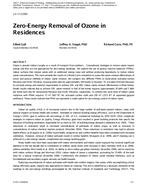Description
Ozone is present indoors largely as a result of transport from outdoors. Conventional strategies to remove ozone require energy and thus are not appropriate for zero-energy buildings. We explore the use of passive reactive materials (PRMs), indoor surfaces that remove ozone with no additional energy input and without producing byproducts, to reduce indoor ozone concentrations. This work presents the results of a Monte Carlo simulation to assess the ozone removal effectiveness of active and passive methods of indoor ozone removal. We compare two different PRMs to stand-alone activated carbon filtration and HVAC filtration. Housing stock data for approximately 100 homes in Houston, TX are taken from the literature to calculate energy and material requirements to achieve 50% and 80% indoor ozone removal effectiveness in these homes. Model results indicate that to achieve 50% ozone removal in half of the homes requires approximately 30 kWh and 5 kWh per home each day for stand-alone filtration and HVAC filtration, respectively. To achieve this same level of indoor ozone reduction with PRMs requires 75 m2 (807 ft2) for activated carbon cloth and 200 m2 (2153 ft2) of unpainted gypsum wallboard. These results indicate that PRM use represents a viable option for zero-energy control of indoor ozone.
Citation: ASHRAE Conference Papers, Las Vegas, NV
Product Details
- Published:
- 2011
- Number of Pages:
- 8
- File Size:
- 1 file , 660 KB
- Product Code(s):
- D-LV-11-C050




